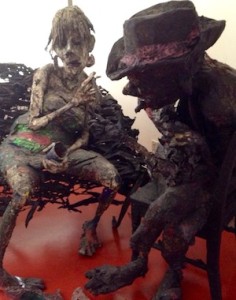Last week I had another delightful Tucson experience when I visited the Process Museum for the first time. What an incredible surprise it was. It is tucked away in a huge (77,000 square feet) warehouse on Kolb Road across the street from the I-10 entrance. It’s the passion and pride of John Wells, who was our guide through this amazing place.
John Wells appreciates and collects art. He also owns this huge property and has dedicated it to exhibiting and honoring creative process of artists. Many of the people who are represented in this showcase have a connection with Tucson.
The goal of the museum is to reveal the totality of the creative process. This means that visitors will see the work of the artist along with all the other kinds of “stuff” an artist has in the studio: furniture, storage lockers, sketch books, note books, reference books, art supplies, wood, canvas, plastic, paper metal, fiber, wire, and fabric waiting to be used. It also includes work in all stages of the creative process from initial conceptualization and layout to iterations of an idea in various stages of development. Walls and corridors are covered with art pieces. One sees an idea explored by the artist multiple times.
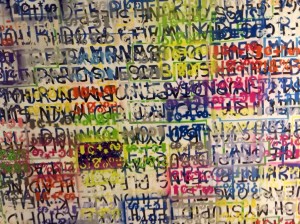
This museum is the repository of more art than I ever imagined I would or could see in a span of two hours. It is overwhelming and absolutely hypnotic in it’s power. As I walked through the space I was consumed by the enormity of the undertaking but also delighted by the opportunity to witness the work. Not just the good work that gets curated into shows but all the other work that gets produced along the way and then hidden in closets or painted over because for some reason the artist has decided it doesn’t work. Let’s face it, much of the work an artist makes is not for public consumption. Making the art is just part of the creative process.
The museum is currently the home base for seven working artists. There were several on site during our visit. We wandered the corridors and peered into the rooms where pieces were in process, stored or displayed.
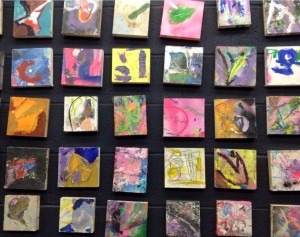
Work ranged from a room filled with 1080 4”x4” pieces done by Thomas Rossi to a show of “Collateral Surfaces” – the surfaces on which art is made (tabletops, drop cloths, palettes etc.) to a room filled with storage shelves crowded with the ceramic pieces of Michael Cajero. The work of the late Owen Williams, a favorite artist of mine, was hung in a room dedicated to him and furnished with tables, chairs and other items from his studio. Across the hall were shelves loaded with the tools he used to make his unique dimensional paintings.
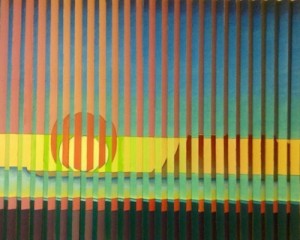
The last stop of our tour was a building completely devoted to the incredible wire and paper sculpture of Michael Cajero. Hundreds of dark pieces tastefully displayed with sensitivity against white walls with red floors and suitable lighting greeted the viewer. I can not tell you how moving it was to see this massive collection. Cajero’s work has energy and excitement. It is complex and yet it is basic. It compels you to look and evokes feeling within you. Wells has aptly labeled the little known or recognized Cajero as one of the most important artist of this century. And after seeing his amazing ceramics and sculptures, I definitely agree with him. Currently Cajero’s 2,500 drawings and paintings have yet to be displayed. It will surely be something to look forward to.
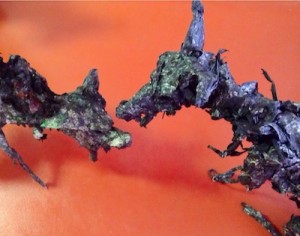
I encourage you to visit this amazing art wonderland at 8000 North Kolb. It is a private collection open to the public by appointment only. You can contact John Wells through the Process Museum’s website www.processmuseum.org or by phone at 520-404-0596.
You won’t be disappointed.
